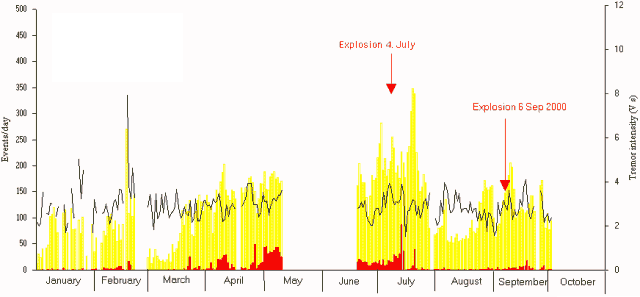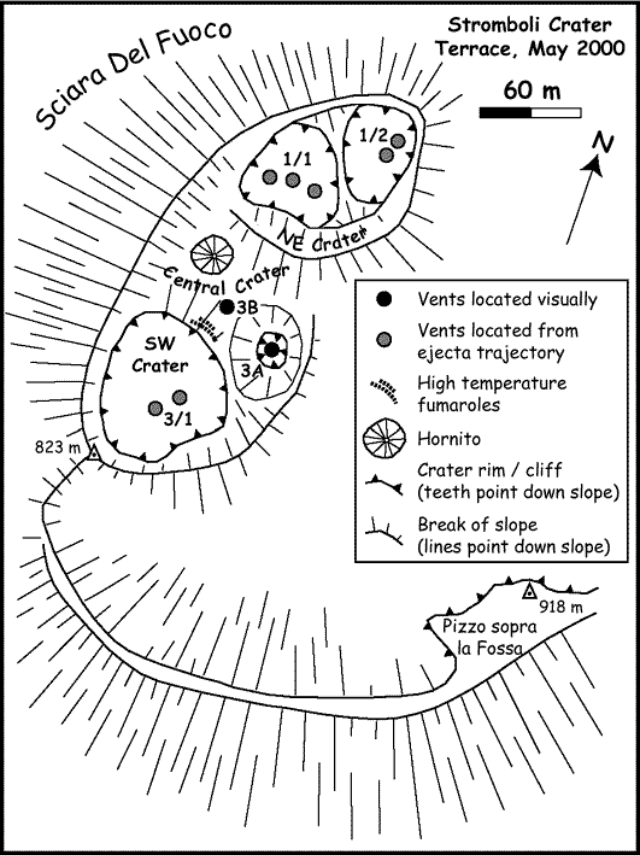Report on Stromboli (Italy) — August 2000
Bulletin of the Global Volcanism Network, vol. 25, no. 8 (August 2000)
Managing Editor: Richard Wunderman.
Stromboli (Italy) Low-to-moderate eruptive activity January-September 2000
Please cite this report as:
Global Volcanism Program, 2000. Report on Stromboli (Italy) (Wunderman, R., ed.). Bulletin of the Global Volcanism Network, 25:8. Smithsonian Institution. https://doi.org/10.5479/si.GVP.BGVN200008-211040
Stromboli
Italy
38.789°N, 15.213°E; summit elev. 924 m
All times are local (unless otherwise noted)
Activity at Stromboli during January-September 2000 was low-to-moderate, as it was throughout 1999 (BGVN 25:01). During a field campaign on 10-19 May 2000 researchers from various universities closely observed activity at the volcano, which resulted in detailed accounts of activity at Stromboli's three main craters. During January-September several small Strombolian eruptions occurred at the volcano, with the largest reported eruptions on 4 July and 6 September 2000.
Activity during January-May 2000. During January and February 2000, low-to-moderate seismicity was recorded by the University of Udine's summit station (figure 61). During the two months there were brief periods with very few seismic events; for example on 1-7 January there were [less than 50] events/day. On 17 February, after a short gap in acquisition, the tremor intensity increased greatly from the average value of [~4 to a peak of ~8] volt seconds (V-s), but then returned to average values the following day.
During the first half of March seismicity was even lower than in the previous months, often with [less than 50] events/day and occasionally (1, 5-9, 11 March) as few as [less than 20] events/day (figure 61). During the second half of March, the number of events returned to normal values (100-120 events/day) and during April increased to 140-160 events/day. Despite the increase in the number of events from March to April, there was no significant variation in tremor intensity.
A technical problem prohibited the acquisition of data at the beginning of May. During 10-19 May the Universities of Udine, Florence, Hawaii, and Open University carried out a field campaign at Stromboli. During the 10 days, scientists collected near-continuous seismic, thermal, and infrasonic measurements. They also constructed an activity log that totaled ~71 hours and was divided into nine 2- to 15-hour long segments that covered all days in the observation period except 13 May. It is important to note that the number of events recorded by the seismic station are not directly comparable to the number of eruptions logged by visual observation because some eruptions may not have produced a seismic signal that was detectable by a short-period seismometer. For this survey the naming convention was changed from previous reports. The craters that were previously named 1,2, and 3, were renamed NE, Central and SW Craters, respectively.
Several active vents were observed in the NE and [SW] craters; up to five were in the NE Crater (figure 62). The western cluster (1/1) consisted of vents that emitted ejecta in three different directions: obliquely to the SW, obliquely to the NE, and symmetrically. This zone was the source of strong nighttime glow, and near-continuous sloshing/puffing sounds that were accompanied by regular emissions of single bombs between Strombolian events. The eastern cluster (1/2) consisted of two vents that would often erupt together. During the night this zone was the source of weak, intermittent glow. Vent clusters 1/1 and 1/2 were located on the floors of two coalesced depressions within the main NE Crater. The SW Crater was the location of at least two active vents (3/1) ~10 m apart on the SE portion of the crater. No night glow was observed from either vent. A zone of high-temperature fumaroles was aligned along crater-bounding fractures at the E rim of the SW Crater.
During 10-14 May, activity at 1/1 was characterized by emissions of molten ejecta in heavily loaded, single-shot fountains that reached heights of 50-350 m and landed as far as ~120 m away to the eastern edge of the SW Crater. Fountain heights and ejected volumes appeared to increase from 10-11 May, when maximum ejecta heights were 100-200 m, to 14 May, when ejecta reached up to 230-350 m. Bombs rarely landed within 50 m of Pizzo sopra la Fossa, which was ~140 m away from the 1/1 vent cluster. The 1/2 vent cluster was the source of pulsing, 20- to 30-second emissions of incandescent ejecta, ash, and gas. Ejecta were emitted in a diffuse spray, and ash-and-gas emissions reached <100 m above the vent. Two vents within 10 m of each other often erupted together 2-4 times per hour, with the westernmost vent usually erupting after the eastern vent began to erupt. Activity at 3/1 was characterized by 10- to 40-second emissions of gas and brown ash, containing minor ejecta. The ash clouds from 3/1 rose up to 300 m above the vent before detaching from it.
Overnight on 14-15 May the style of activity changed when all vents switched to gas-dominated emissions that reached lower heights (<75 m) than previously. Events also became increasingly quiet, such that by the evening of 15 May some emissions were completely silent. Ejections from 1/1 continued to be short, 1- to 2-second, single-shot events, but they contained low volumes of molten ejecta with minor amounts of ash. The ejections rose <75 m above the vent with gas being the dominant component. At 1/2 the emissions were gas dominated. Long-lasting emissions at 3/1 consisted almost entirely of gas and rose <100 m above the vent. This gas-dominated style of activity continued until the final day of observations on 19 May.
During the activity change the frequency of events remained relatively stable, with 11-17 events/hour. During 10-14 May the frequency decreased at 1/1 from 6-7 events/hour to 3-6 events/hour, and during 15-19 May increased at 3/1 from 2-5 events/hour to 5-8 events/hour.
The Central Crater was not active during the observation period. The hornito initially observed during July 1999 (BGVN 24:06) was the source of low-temperature fumarolic activity. The Central Crater was entirely filled, resembling a saddle between the SW and NE Craters, rather than a crater. The deep, funnel-shaped pit SE of the Central Crater that developed during 1997-99 (BGVN 24:06) appeared to be a well-established feature. Its morphology suggested that it was an eastern extension of the SW Crater with a low septum separating it from the SW Crater.
An ~5-m-wide, persistently degassing active vent (3A) was observed on the floor of the funnel-shaped pit. Another actively degassing vent (3B), which was established on the NW rim of the 3A pit during July 1999, was ~2 m wide and was not surrounded by any constructive features (e.g. hornito, spatter rampart, or crater features), suggesting that eruptions were rare or did not occur from it. A maximum temperature of 639°C was measured from the gas-heated walls of vent 3B. However, the temperature of vent 3B was variable and during low-activity periods the vent temperature fell below 550°C (the lowest detection limit of the thermal infrared thermometer). The variation in temperature was obvious during the day from increases and decreases in the vigor of degassing: vigorous degassing occurred at high temperatures, and weak degassing occurred at low temperatures. Similar variations in glow, temperature, and degassing were observed at vent 3A. The activity at 3A and 3B vents appeared to be inversely correlated; a decrease in temperature and degassing at 3B would often synchronize with an increase at 3A, and vice versa.
Overall, during the observation period a total of 916 Strombolian events were recorded, with 383, 198, 335 events occurring at vent clusters 1/1, 1/2, and 3/1, respectively. The overall eruption rate was 13 events/hour, with a range of 6-20 events/hour and a typical repose of 5 minutes (the maximum repose was 37 minutes). Breaking these statistics down by vent, 1/1, 1/2, and 3/1 were respectively active with 5, 3, and 5 events/hour, with ranges of 0-12, 0-6, and 0-9 events/hour, and mean reposes of 12, 22, and 12 minutes (the maximum repose times were 194, 136, and 117 minutes).
Activity during June to mid-August. According to Sistema Poseidon, during mid-to-late June there was frequent Strombolian activity of medium intensity, with tephra reaching ~100-150 m above the crater's edge. This activity was regular, with about one event every 20 minutes and less regular ejections of ash and secondary debris coming from a second active vent in the same crater. By the end of June activity at the other summit craters was limited to abundant steam emissions. In early August, explosive eruptions occurred primarily in the northern vent and more sporadic eruptions occurred in the southern vent.
Small eruptions on 4 July and 6 September. Stromboli On-Line reported that at about 0935 on 4 July two large explosions were separated by 1-2 seconds. Only a small amount of ash was observed from the eruptions. They also reported that at 0554 on 6 September a violent eruption woke up the population. The ash cloud from the eruption rose to at least 1 km in altitude. The timing of the eruptions is shown on the plots of event frequency and intensity during January-September (figure 61).
Geological Summary. Spectacular incandescent nighttime explosions at Stromboli have long attracted visitors to the "Lighthouse of the Mediterranean" in the NE Aeolian Islands. This volcano has lent its name to the frequent mild explosive activity that has characterized its eruptions throughout much of historical time. The small island is the emergent summit of a volcano that grew in two main eruptive cycles, the last of which formed the western portion of the island. The Neostromboli eruptive period took place between about 13,000 and 5,000 years ago. The active summit vents are located at the head of the Sciara del Fuoco, a prominent scarp that formed about 5,000 years ago due to a series of slope failures which extends to below sea level. The modern volcano has been constructed within this scarp, which funnels pyroclastic ejecta and lava flows to the NW. Essentially continuous mild Strombolian explosions, sometimes accompanied by lava flows, have been recorded for more than a millennium.
Information Contacts: Andy Harris, Department of Earth Sciences, The Open University, Milton Keynes, MK7 6AA, U.K.; Roberto Carniel, Dipartimento di Georisorse e Territorio, Università di Udine, via Cotonificio 114, I-33100 Udine, Italy (URL: http://www.swisseduc.ch/stromboli/); Maurizio Ripepe, Dipartimento di Scienze della Terra, Università di Firenze, via G. La Pira 4, I-50121 Firenze, Italy; John Bailey, Department of Geology and Geophysics, SOEST, University of Hawai' i, 2525 Correa Road, Honolulu, HI 96822, USA; Stromboli On-line, maintained by Jürg Alean and Roberto Carniel (URL: http://www.swisseduc.ch/stromboli/); Jürg Alean, Kantonsschule Zürcher Unterland, CH8180 Bülach, Switzerland; Sistema Poseidon, a cooperative project supported by both the Italian Government and the Sicilian Regional Government, and operated by several scientific institiutions (URL: http://www.ct.ingv.it/en/chi-siamo/la-sezione.html).



